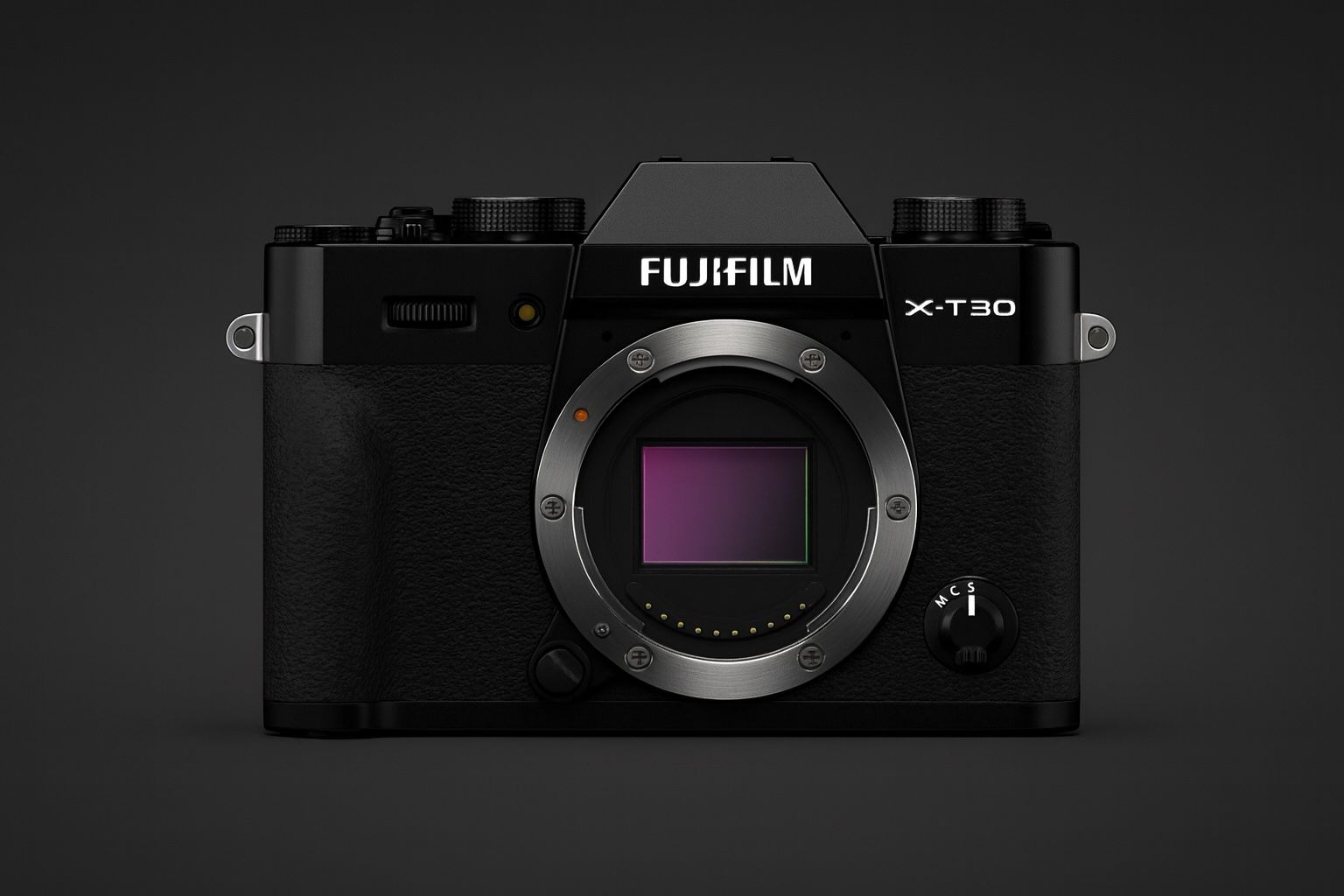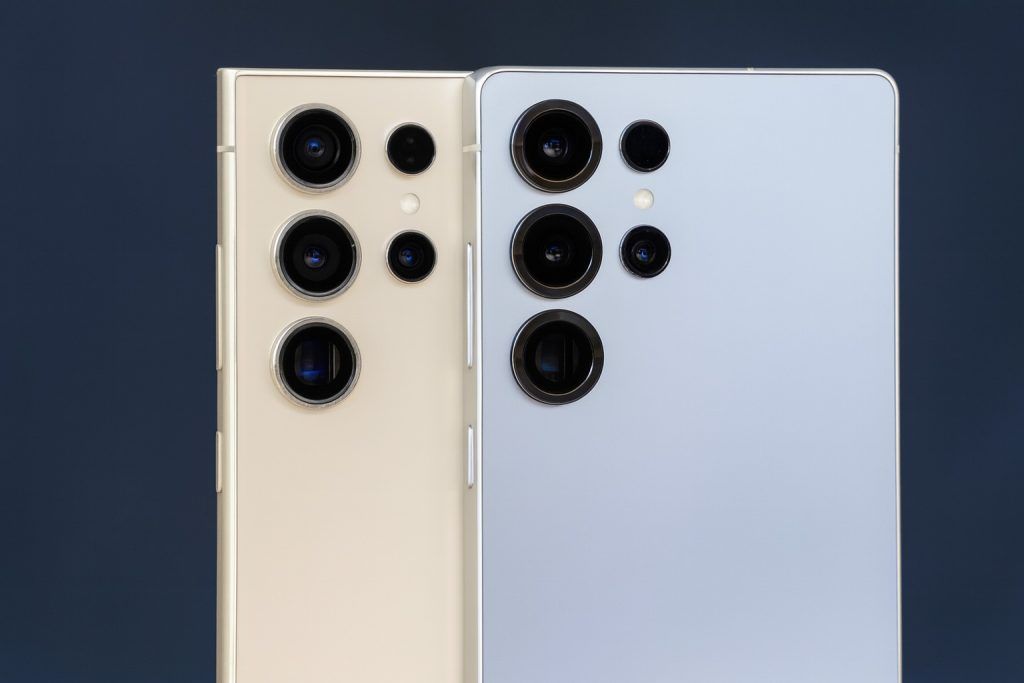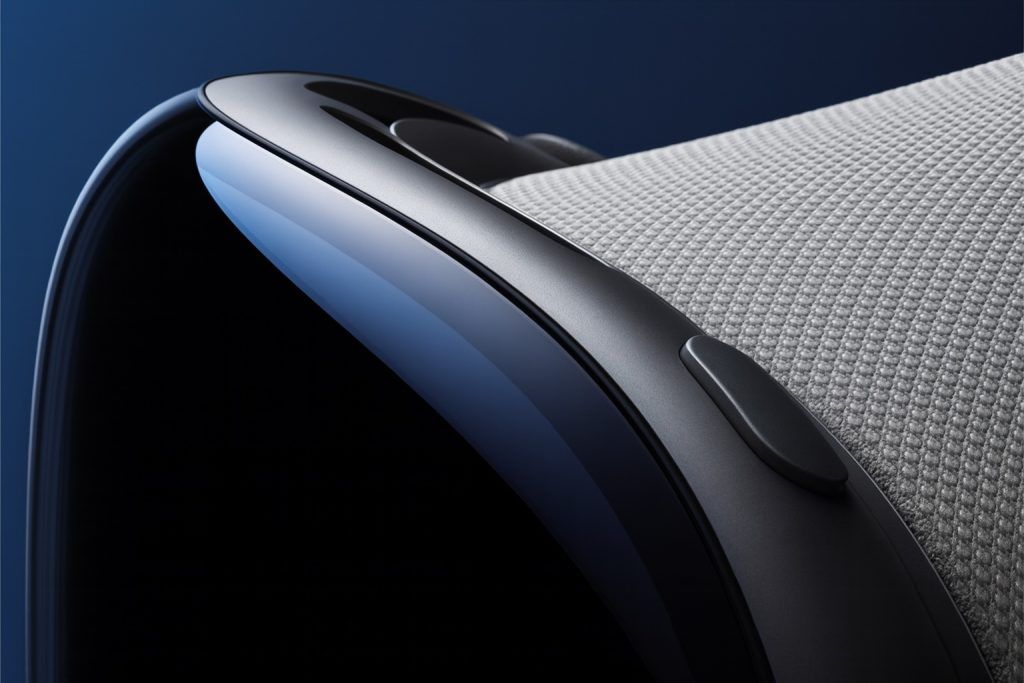- New Fujifilm X-T30 III Coming: Rumors point to an October 2025 launch for the Fujifilm X-T30 III, a successor to the mid-range X-T30 II [1]. Retailer listings suggest the X-T30 II is being phased out, fueling anticipation for this new model [2].
- 26MP Sensor + 5th-Gen Processor: A trusted source confirms the X-T30 III will pair Fujifilm’s proven 26.1-megapixel X-Trans CMOS 4 sensor with the latest X-Processor 5 chip [3]. This “lovely combo” (also used in the X-S20) promises faster readout, cooler operation, and lower cost than Fuji’s high-res 40MP sensor [4].
- Performance Boosts Expected: With the new processor, the X-T30 III should deliver improved autofocus/tracking and faster burst shooting. Insiders say it will be on par with the performance of the X-S20 camera [5]. The current X-T30 II tops out at 8 fps (mechanical) and 20 fps (electronic) bursts [6], so Fujifilm may aim to raise those speeds to catch up with rivals (some competing models shoot 11–15 fps mechanical and up to 30 fps electronic) [7].
- Will It Have IBIS? In-body image stabilization (IBIS) is a hot wishlist item. Fujifilm managed to include 5-axis IBIS in the compact X-S20, and if the X-T30 III follows suit, it would offer up to 4–5 stops of shake reduction – a huge boon for handheld shots [8]. However, leaks suggest Fuji might omit IBIS to keep the price down [9]. Without IBIS, the X-T30 III would likely launch at a more affordable price than the $1,499 X-S20 or $1,599 X-T50 [10].
- Return to Affordable Roots: The X-T30 III is poised to be a “more affordable, compact alternative to Fujifilm’s pricier X-T50” model [11]. It will continue the X-T series legacy of photography-focused controls – traditional dials and retro styling – which many enthusiasts prefer over the modern PASM controls on cameras like the X-S20 [12]. A new Fujinon XC 13-33mm f/3.5-6.3 kit lens is rumored to launch alongside the X-T30 III, indicating Fuji’s intention to offer a compelling bundle for beginners and enthusiasts alike [13].
X-T30 II Discontinued? Signs Point to a Successor Imminent
The Fujifilm X-T30 II (released in 2021) has recently become scarce at major retailers, hinting that its successor is on the way. In late September, B&H Photo briefly marked the X-T30 II as “Discontinued” on their website, even emailing customers that the model was no longer available [14] [15]. While B&H later changed the status to “Temporarily Out of Stock,” the message was clear – new stock isn’t flowing. Amazon listings likewise showed only a handful of units left, with no replenishments in sight [16].
Fujifilm’s 2019 X-T30 and the 2021 X-T30 II were beloved mid-range mirrorless cameras, offering Fuji’s X-Trans sensor magic in a compact body. Notably, the X-T30 II was almost identical to the original X-T30, essentially a mild refresh that kept the 26.1MP sensor and X-Processor 4, and launched at a $999 body-only price [17]. Meanwhile, competing brands surged ahead with faster shooting speeds and smarter autofocus. Canon’s EOS R10 (2022) can burst at 15 fps (mechanical) [18], Nikon’s new Z50 II hits 11 fps (mechanical) and up to 30 fps electronic [19], and Sony’s latest A6700 recognizes not just human eyes but animals too [20]. By comparison, the X-T30 II’s 8 fps mechanical burst and human-only eye detect AF were beginning to lag behind.
These competitive pressures, combined with the stock shortages, have Fujifilm fans optimistic that a big X-T30-series upgrade is imminent [21]. Industry watcher Imaging Resource notes that the apparent discontinuation of the X-T30 II is “a reason for cautious optimism” as rumors of an X-T30 III (or X-T40) swirl [22]. In other words, Fuji seems to be “clearing the way” for a new model – even if the company hasn’t officially said so.
Interestingly, Fujifilm officially denies discontinuing the X-T30 II. In response to the reports, a Fujifilm representative told PetaPixel on September 26 that “the Fujifilm X-T30 II is not discontinued and is an active part of our X Series lineup at this time” [23]. The company gave no hint of an X-T30 II successor when asked [24]. Fuji suggested the B&H listing was a mix-up due to inventory policy, not a signal of a new camera [25]. However, most observers aren’t buying that as the whole story. The rumor mill (with a solid track record) insists the X-T30 II is quietly being phased out and its successor “is coming in October” despite official coyness [26]. All signs – from retailer behavior to Fujifilm’s own website slowly delisting X-T30 II kits [27] – point to a new model about to drop.
The X-T30 III’s Rumored Specs: 26MP X-Trans Sensor Meets X-Processor 5
According to reliable leaks on FujiRumors (a site known for accurate Fuji intel), the Fujifilm X-T30 III will carry over the 26.1MP APS-C X-Trans CMOS 4 sensor from its predecessor, but upgrade to the latest 5th-generation processor [28] [29]. In essence, it’s getting the brain transplant many were hoping for. The X-Trans 4 sensor, used in cameras like the X-T4 and X-T30 II, is a proven performer with excellent image quality and a unique color filter array beloved by Fuji shooters. Sticking with this 26MP sensor makes sense – as one analyst noted, “resolution is not an area that needs an upgrade” since 26 megapixels is already class-leading among APS-C cameras in this class [30].
What does change is the processing engine. The X-T30 III will reportedly use the X-Processor 5, the same powerful chip found in Fujifilm’s newest high-end models (such as the X-T5, X-H2, X-H2S, and the upcoming X100 VI) [31]. This is a big deal: the 5th-gen processor brings major improvements in speed, autofocus algorithms, video capabilities, and overall throughput. By contrast, the outgoing X-T30 II uses the older X-Processor 4. Upgrading to X-Processor 5 should yield snappier performance across the board – from menu navigation to image processing and shot-to-shot times.
Crucially, pairing the X-Trans 4 sensor with the X-Processor 5 is a combination Fujifilm has already implemented with great success in the recent Fujifilm X-S20 [32]. FujiRumors calls it a “great and efficient combo” that offers faster sensor readout and less heat generation [33]. In practical terms, faster readout means reduced rolling shutter distortion in electronic shutter mode and potentially higher burst rates. Less heat means the camera can record longer video clips or shoot bursts without overheating, despite the small body. And an added bonus: by reusing the 26MP sensor, Fujifilm avoids the higher cost of the newer 40MP sensor (as used in the X-T5/X-T50), helping keep the X-T30 III’s price down [34].
So, what kind of performance boost can we expect from this sensor+processor update? For one, autofocus should see a notable leap forward. The X-Processor 5 enables more advanced AF algorithms – including improved subject detection (animals, vehicles, etc.) and better tracking of moving subjects. The X-T30 II could already detect human faces/eyes reliably, but it lacked the broader subject recognition that competitors offer [35]. With the new processor, the X-T30 III is likely to inherit the sophisticated AF from cameras like the X-T5 and X-H2, meaning it could lock onto cats, dogs, birds, and more – not just people – and keep them in focus. Fuji users have seen these AI-driven AF improvements trickle down from flagship models, and an X-T30 III would finally bring those to the mid-tier lineup.
Speed and Shooting Features: Catching Up to Competitors
Another area ripe for improvement is continuous shooting speed. The current X-T30 II’s burst rates (up to 8 fps with mechanical shutter, or 20 fps electronic; 30 fps if you accept a 1.25× crop) were decent in 2019 but now merely average [36]. Rival cameras in the sub-$1000 category have edged ahead. Nikon’s midrange Z50 series can shoot 11 fps with the mech shutter (and an impressive 30 fps electronically) [37]. Canon’s EOS R10 manages 15 fps mechanical / 23 fps electronic [38]. Sony’s new A6700 hits 11 fps and offers cutting-edge tracking at those speeds [39].
To stay competitive, Fujifilm will likely boost the X-T30 III’s burst capabilities. Thanks to the X-Processor 5’s higher throughput, a reasonable expectation is something like 10 or 11 fps with the mechanical shutter (matching Nikon’s midrange) and possibly around 20+ fps with electronic shutter without crop. Fuji could even push toward that 30 fps mark in a cropped mode if thermal limits allow. We’ll have to wait for official specs, but it’s clear Fujifilm is aware that shooting speed is a selling point – the company’s higher models (e.g. the stacked-sensor X-H2S) emphasize speed, and some of that tech tends to filter down over time.
Video features should also see an uptick. The X-T30 II already delivers oversampled 4K/30p video using the full sensor (downsampling from 6K capture) [40] for very sharp footage. However, it lacks 4K/60p capability and uses a 1.25× crop for its highest 30 fps bursts, indicating the limits of the older processor. With the new processor, the X-T30 III might gain 4K/60p video recording, possibly with a slight crop if needed. Fujifilm managed 4K/60p on the X-T4 (which used the same 26MP sensor but a bigger body and cooling) and on the X-S20 (with the new processor), so it’s plausible the X-T30 III will join the 4K60 club – a nice upgrade for videographers and vloggers on a budget. At the very least, we can expect improved video autofocus and maybe longer recording times before overheating, thanks to that more efficient chip [41].
One wish-list item for continuous shooting is a deeper buffer – the X-T30 II could capture around 90 JPEGs or 18 RAW frames in a burst before slowing. The X-Processor 5, with faster write speeds, might help the X-T30 III clear its buffer quicker, allowing for longer bursts. This will benefit sports and wildlife shooters who rely on capturing the right moment in fast action.
In-Body Stabilization: Will Fuji Include IBIS in the X-T30 III?
Perhaps the biggest question mark is IBIS (In-Body Image Stabilization). Camera enthusiasts have been eagerly debating whether Fujifilm will equip the X-T30 III with sensor-shift stabilization. On one hand, IBIS has become increasingly common even in mid-tier cameras – it’s a feature that can be a game-changer for low-light photography and steady video. A stabilized sensor can compensate for 4–5 stops of shake, allowing sharper handheld shots at slower shutter speeds. Notably, none of the X-T30 series predecessors had IBIS, and historically Fuji reserved IBIS for higher-end or specific models (like the X-H line and X-T4/T5). But Fujifilm shook things up by putting IBIS into the X-S10 and X-S20, which are smaller cameras not far in size from the X-T30 series. This proved IBIS can be implemented in compact bodies without breaking the bank – the X-S20 offers 5-axis stabilization and starts around $1,299–$1,499, well below flagship prices.
Industry experts have pointed out that adding IBIS to the X-T30 III would be a “substantial deal”, instantly giving it a leg up in the mid-range class where stabilization is still relatively rare [42]. For context, Canon’s and Nikon’s midrange APS-C mirrorless models lack IBIS, and only much pricier cameras (or Micro Four Thirds models like the $1,849 OM System OM-3) include it [43]. So a stabilized X-T30 III could undercut competitors by offering a feature usually found in higher tiers.
However, the latest leaks suggest IBIS might be sacrificed to keep the X-T30 III’s price truly “affordable.” According to a report on Notebookcheck, since the X-T30 III is positioned as a cheaper alternative to the $1,599 X-T50, Fujifilm may decide that “IBIS may have to be on the chopping block” to meaningfully differentiate the models [44]. In other words, Fuji could omit stabilization in the X-T30 III to ensure it comes in at a lower cost than the X-T50 and X-S20 (both of which do have IBIS and higher price tags). If that’s the case, the X-T30 III might essentially be an X-S20 without IBIS but with classic controls, hopefully priced around or below the X-T30 II’s $999 launch price.
On the other hand, it’s possible Fujifilm surprises us and includes IBIS, making the X-T30 III incredibly compelling for the price. Photographers would certainly welcome it – sharper shots and smoother video in such a compact camera would be a huge selling point. The decision likely comes down to market segmentation: Fuji has to balance the feature set so that each model (X-S20, X-T30 III, X-T50, etc.) has its place without cannibalizing each other. Enthusiasts are keeping their fingers crossed, but realistically prepared that IBIS might stay exclusive to the slightly higher tiers.
Positioning in Fujifilm’s Lineup: Back to Basics, and Competing Models
The X-T30 III arrives at an interesting time in Fujifilm’s lineup. Fujifilm has been expanding its X-series offerings rapidly. In 2024, Fuji introduced the X-T50, an entirely new model number for the X-T line [45]. Despite what its name might suggest, the X-T50 isn’t exactly a direct successor to the X-T30 II – it launched at a much higher price point (around $1,599 body-only) [46] and likely sports more advanced specs, possibly even the 40MP sensor. The X-T50 appears to target upper-midrange users, sitting between the $1,699 X-T5 flagship APS-C and the older mid-tier. It also coincided with the release of the long-awaited X-E5 rangefinder-style camera [47].
By comparison, the X-T30 III is expected to “return to the affordable roots of the X-T line” [48] – essentially filling the gap left by the X-T30 II in the sub-$1000 category. This camera is aimed at enthusiast photographers who want Fujifilm’s imaging prowess and retro ergonomics in a smaller, lighter body that won’t break the bank. It’s the spiritual successor to the popular X-T20 and X-T30 which hit the sweet spot for many hobbyists. As Notebookcheck puts it, the X-T30 III would be “a compact camera that would serve as something between the existing X-T30 II and the X-T50” in features and price [49].
Crucially, the X-T30 III will likely maintain the classic Fujifilm control scheme that the X-T series is known for – dedicated shutter speed and exposure compensation dials, and an aperture ring on many lenses. These tactile controls are a major draw for Fuji’s audience, offering a retro shooting experience reminiscent of film SLRs. The more recent X-S10/X-S20, while excellent, use a conventional mode dial and more of a DSLR-style interface, which some traditionalists find less appealing. Many prospective buyers of the X-S20 “have long been looking for” a camera like the X-T30 III – essentially X-S20-level guts in a body with old-school dials and photography-focused ergonomics [50]. Fujifilm seems ready to deliver exactly that.
In the broader market, the X-T30 III will compete with cameras like Canon’s EOS R10/R8, Nikon’s Z50/Zfc, and Sony’s A6700/A6600. Fuji’s edge has always been its combination of image quality, unique color science (Film Simulations), and those beloved analog controls. If the rumors hold true, the X-T30 III will bolster that formula with modern performance – potentially outclassing rivals on resolution (26 MP vs. many peers at 20-24 MP), matching or exceeding them in burst speed and AF, and undercutting some on price. The one area to watch will be video: Canon and Sony offer strong video specs in this segment (the Canon R10 does 4K60 with a crop, Sony A6700 does 4K60 and even 4K120 in a higher model), so Fujifilm will want the X-T30 III to at least hit 4K60 and showcase its own video prowess (perhaps with Fuji’s popular Eterna film simulation for a cinematic look).
Expected Announcement, Pricing, and the New Kit Lens
Multiple sources agree that Fujifilm will officially announce the X-T30 III in October 2025 [51] [52]. FujiRumors, which first broke the news, confidently reports an October announcement and is already counting down the days. As of early October, no press invites or teasers have been spotted, but Fujifilm often drops new products either via press release or at dedicated X-Summit events. It’s possible the X-T30 III could be unveiled alongside other products – for instance, Fujifilm has recently been updating its lens lineup and even launched a medium-format GFX100 II in September. If an X-Summit or product event is scheduled in late October, the X-T30 III will likely be a highlight.
Pricing for the X-T30 III remains speculative, but given Fujifilm’s positioning, enthusiasts hope it lands around the same price as the X-T30 II’s debut ($900–$1000 range for the body). Keeping it under the psychologically important $1,000 mark would make it very attractive. It’s worth noting that the market has seen some inflation: the X-S20 (with kit lens) can run about $1,399-$1,499, and the X-T50 (body-only) is ~$1,599 [53]. If the X-T30 III lacks IBIS and some high-end features, Fuji could price it closer to $999 body-only. There may also be one or two kit options offered with a zoom lens.
In fact, rumors suggest a brand-new kit lens will debut with the X-T30 III. FujiRumors has reported that a Fujinon XC 13-33mm f/3.5-6.3 lens will be launched alongside the camera, likely as the default kit zoom [54]. This would be a compact, entry-level zoom (13-33mm roughly equates to 20-50mm in full-frame terms) presumably designed to be light, affordable, and versatile for everyday shooting. It might replace the older XC 15-45mm f/3.5-5.6 OIS PZ as the go-to kit lens for Fuji’s lower tier. The XC 13-33mm is expected to be offered in kits and signals Fuji’s commitment to making the X-T30 III a friendly option for newcomers (XC lenses are the cheaper line without aperture rings, but often optically good for the price). For more advanced users or those upgrading, the X-T30 III body will of course be compatible with Fujifilm’s extensive XF lens lineup, from compact primes to pro zooms.
What Photographers Are Saying and Final Thoughts
The buzz around the Fujifilm X-T30 III is palpable in the photography community. Many Fujifilm fans who sat out the X-T30 II (due to its modest upgrades) are eager for a true next-generation model. Experts and journalists are weighing in with both excitement and realistic caution. “With no significant price drops on the older models and precedent for improvements in a possible X-T30 II successor, Fujifilm fans may have reason for hopeful anticipation,” writes Imaging Resource, capturing the hopeful mood [55]. The consensus is that Fujifilm needs to bring the X-T30 series up to speed, and if the rumored specs are accurate, it will do just that.
At the same time, seasoned observers note that Fujifilm has a delicate balancing act. The company surprised some by introducing the X-T50 at a higher price tier, which initially led folks to wonder if X-T30 II would be the last of its line. Fuji’s official stance that “no hints to any X-T30 II successor have been given” [56] [57] was taken with a grain of salt – likely an attempt not to stall existing model sales. Now, with solid leaks and even Fujifilm’s own actions (like quietly pulling X-T30 II listings) pointing to the X-T30 III, it seems clear this camera is real and almost here. FujiRumors, after sorting through the evidence, flatly stated: “the X-T30 III is coming in October. No matter how strongly Fujifilm denies it, our sources confirm it’s happening.” [58]
For photographers, the X-T30 III represents an exciting promise: the familiar Fuji X-T experience with modern internals. Imagine the image quality and snappy responsiveness of the latest Fujis, distilled into a small body with those satisfying dials – and at a price accessible to enthusiast shooters. If Fujifilm nails that formula, the X-T30 III could be one of the most compelling cameras of the year for hobbyists and even as a lightweight second body for pros. It essentially continues Fuji’s trend of trickling down high-end tech into lower-cost models, much like how the earlier X-T30 inherited the sensor of the flagship X-T3.
In summary, the Fujifilm X-T30 III is shaping up to be a welcome refresh of a popular camera line. Leaks point to the right upgrades (new processor, same great sensor) that address the X-T30 II’s aging performance. Key questions like IBIS and exact pricing remain, but either way, Fujifilm appears ready to double down on offering a “modern, affordable, more compact camera for photography lovers” in the X-mount family [59]. All eyes are now on Fujifilm’s October announcements – fans will be watching to see if this rumored gem becomes reality. Stay tuned, because if the chatter is correct, we’ll officially meet the X-T30 III in a matter of weeks, and find out if it’s the big upgrade everyone’s been hoping for.
Sources: FujiRumors [60] [61]; Imaging Resource [62] [63] [64]; Notebookcheck [65] [66] [67]; FujiRumors (lens kit) [68]; PetaPixel [69] [70]; FujiRumors (discontinuation) [71].
References
1. www.notebookcheck.net, 2. www.imaging-resource.com, 3. www.fujirumors.com, 4. www.fujirumors.com, 5. www.notebookcheck.net, 6. petapixel.com, 7. www.imaging-resource.com, 8. www.imaging-resource.com, 9. www.notebookcheck.net, 10. www.notebookcheck.net, 11. www.notebookcheck.net, 12. www.notebookcheck.net, 13. www.fujirumors.com, 14. www.fujirumors.com, 15. www.fujirumors.com, 16. www.imaging-resource.com, 17. www.imaging-resource.com, 18. www.imaging-resource.com, 19. www.imaging-resource.com, 20. www.imaging-resource.com, 21. www.imaging-resource.com, 22. www.imaging-resource.com, 23. petapixel.com, 24. petapixel.com, 25. petapixel.com, 26. www.fujirumors.com, 27. www.fujirumors.com, 28. www.fujirumors.com, 29. www.notebookcheck.net, 30. www.imaging-resource.com, 31. www.notebookcheck.net, 32. www.fujirumors.com, 33. www.fujirumors.com, 34. www.fujirumors.com, 35. www.imaging-resource.com, 36. petapixel.com, 37. www.imaging-resource.com, 38. www.imaging-resource.com, 39. www.imaging-resource.com, 40. www.imaging-resource.com, 41. www.fujirumors.com, 42. www.imaging-resource.com, 43. www.imaging-resource.com, 44. www.notebookcheck.net, 45. www.notebookcheck.net, 46. www.notebookcheck.net, 47. www.notebookcheck.net, 48. www.notebookcheck.net, 49. www.notebookcheck.net, 50. www.notebookcheck.net, 51. www.fujirumors.com, 52. www.notebookcheck.net, 53. www.notebookcheck.net, 54. www.fujirumors.com, 55. www.imaging-resource.com, 56. petapixel.com, 57. petapixel.com, 58. www.fujirumors.com, 59. www.notebookcheck.net, 60. www.fujirumors.com, 61. www.fujirumors.com, 62. www.imaging-resource.com, 63. www.imaging-resource.com, 64. www.imaging-resource.com, 65. www.notebookcheck.net, 66. www.notebookcheck.net, 67. www.notebookcheck.net, 68. www.fujirumors.com, 69. petapixel.com, 70. petapixel.com, 71. www.fujirumors.com










